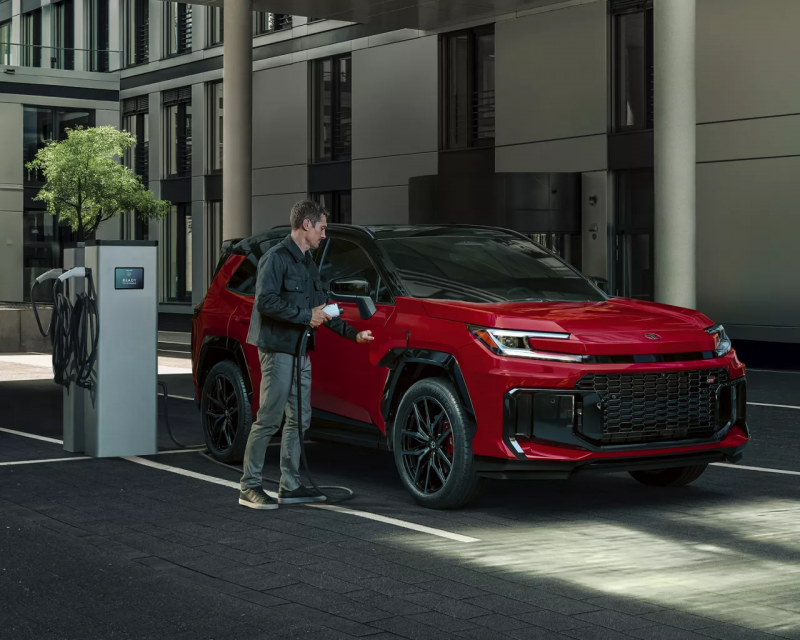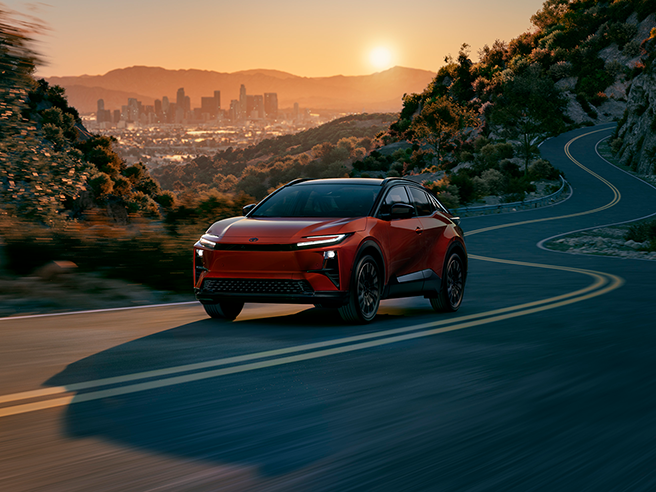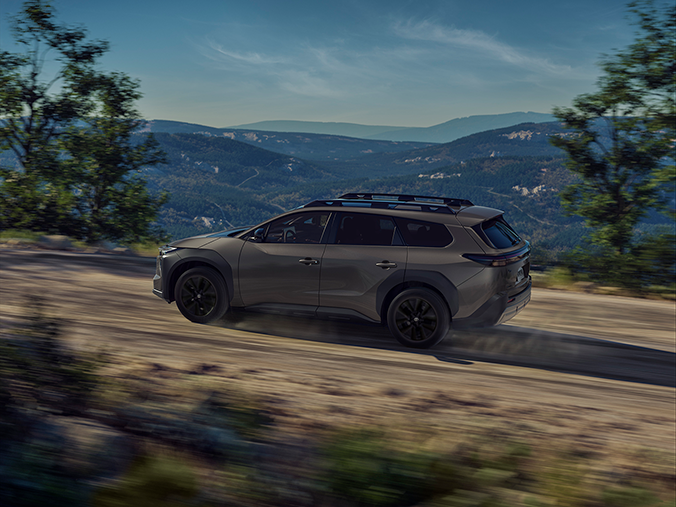Toyota Hybrid & EV Guide
Toyota has always been at the forefront of innovation toward electrification. The introduction of the Prius Hybrid in 1997 changed the way the world thinks about mobility. Since then, they've expanded its lineup to include more Hybrid Electric Vehicles (HEVs), Plug-in Hybrids (PHEVs), Hydrogen Fuel Cell EVs (FCEVs), and Battery Electric Vehicles (BEVs).
This guide will simplify the jargon and break down all the Toyota Hybrid and Electric Vehicles (EVs) vehicles for you.
Rest assured that as Canada's highest-selling hybrid dealer for two years in a row, Destination Toyota Burnaby is equipped with the inventory and expertise to get you your dream electrified vehicle.

Hybrid Electric Vehicle (HEV)
A hybrid electric vehicle (HEV) is likely the type of hybrid you know best. HEVs combine a gas engine with an electric motor, generating electricity as you drive—so they never need to be plugged in. Toyota’s Hybrid Synergy Drive seamlessly, and automatically, chooses the most efficient source and blend of power. Low speeds primarily use the electric motor, while regenerative braking converts braking energy into electric energy to help recharge the battery.
A power-split device and advanced energy management system optimize power flow, helping deliver exceptional performance and fuel economy — up to 70% cleaner than conventional gas engines. Today, nearly every Toyota model is available as a hybrid, continuing Toyota’s legacy of electrified innovation.
Watch the video to see how the Toyota Hybrid System works and discover the technology that powers millions of Toyota vehicles worldwide.
Hybrid FAQs
Q1: Do Toyota hybrids cost more to maintain than gas vehicles?
A: No. Toyota hybrids often require less maintenance. The engines run only part of the time, reducing wear and tear. Regenerative braking extends the life of pads and rotors. Plus, there are no starters, alternators, or belts to replace, and no transmission fluid under load.
Q2: Are Toyota hybrids expensive to run?
A: Not at all. Toyota hybrids are known for reliability and low operating costs. Taxi fleets in Vancouver and Winnipeg have relied on them for over a decade, saving on fuel and logging millions of kilometres—some surpassing 1,000,000 km.
Q3: Do hybrid batteries need to be replaced often?
A: Rarely. Over 99% of Toyota hybrids sold since 2000 are still running on their original battery. Designed to last the life of the vehicle, hybrid batteries are also covered by an 8-year / 160,000 km warranty.
Q4: How do Toyota hybrids compare to diesels?
A: Toyota hybrids are much cleaner. Modern diesel engines emit nearly three times more smog-forming emissions than Toyota hybrids, which rank among the cleanest vehicles on the road.
Q5: Do I need to charge my hybrid car?
A: You cannot plug in to recharge a regular hybrid. The electric motor saves energy that would normally be lost when you slow down. It turns that energy into electricity through a process called regenerative braking. When needed, the engine can also be used to generate electricity.
Plug-in Hybrid Electric Vehicle (PHEV)
Plug-in Hybrid Electric Vehicles (PHEVs) combine the benefits of both gas and electric power for greater efficiency and flexibility. Just as inregular hybrids, Plug-In Hybrids use a gas engine and an electric motor — but with a larger battery that allows for longer all-electric driving. You can plug them in to extend electric range, and when the battery runs low, the gas engine automatically takes over. Regenerative braking also helps recharge the battery as you drive, maximizing efficiency on every trip.
Watch the video below to see how Toyota’s Plug-In Hybrid Prime powertrain works — and why it’s the ultimate choice for efficiency, flexibility, and everyday performance.
Prius Plug-In Hybrid
The Toyota Prius Plug-In Hybrid is a perfect example of this. It has the ability to commute up to 72km and reach 180km/h in EV mode. Additionally, it has a combined range of up to 1,035km. It also has one of the fastest charging times in its class, with no additional special equipment needed.
Coming Soon: 2026 RAV4 Plug-In Hybrid
The all-new 2026 RAV4 Plug-In Hybrid is coming soon! Featuring a powerful 320-horsepower powertrain with an increased electric-only driving range up to 82 km, and 0-100 km/h capability in less than 6 seconds. Moreover, it supports DC fast charging, allowing charging from 10% to 80% in roughly 30 minutes. Stay tuned for more updates.

Plug-In Hybrid FAQs
Q1: Are PHEVs the same as regular hybrids?
A: No. PHEVs have larger batteries which allows electric power alone on shorter trips. For longer drives, PHEVs seamlessly switch to hybrid mode.
Q2: Do I always need to charge a PHEV?
A: No. Charging is optional for PHEVs. However, if you keep a PHEV charged, it maximizes fuel savings. When needed, the gas-hybrid engine acts as a backup.
Q3: Aren’t PHEVs too expensive?
A: While the upfront cost may be higher, available incentives and lower fuel use can save you money over time.
Q4: Is charging a PHEV complicated?
A: Not at all. Most PHEVs can be charged from a standard home outlet—no special equipment required.
Q5: Are PHEVs underpowered?
A: Quite the opposite. Electric torque in PHEVs provides quick and responsive acceleration, ideal for city and highway driving.
Battery Electric Vehicle (BEV)
Battery Electric Vehicles (BEVs) are what people usually refer to these days when they're talking about EVs. BEVs feature much larger batteries than regular Hybrids and Plug-In Hybrid vehicles and thus offer a much longer electric range. They produce zero emissions and needed to be plugged in to charge. They can also utilize strong regenerative braking to extend range. Toyota’s BEV lineup is updating and expanding, so please stay tuned for the latest developments.
Watch the video to learn more about how BEVs work
Toyota bZ
The brand new Toyota bZ is already here! This BEV is loaded with the latest Toyota advanced technology that facilitates smooth, safe and most importantly zero-emission driving experience.

Coming Soon: The All New 2026 bZ Woodland & 2026 CH-R
The all-new Toyota bZ Woodland is built to take you off the grid and into adventure. Blending comfort, style, and confident all-electric performance, it’s designed to make every journey feel effortless. Step inside, and you’ll be ready to explore new horizons with power, freedom, and fun. The All-New All-Electric 2026 Toyota C-HR brings bold energy, premium features, and standout style. Get ready for confidence-inspiring performance that turns everyday drives into exciting adventures.
Battery Electric Vehicle FAQs
Q1: Aren’t EVs too expensive?
A: The upfront cost can be higher, but EVs save money over time with lower fuel and maintenance expenses.
Q2: Don’t EVs have limited range?
A: Many modern EVs can travel over 400 km on a single charge—more than enough for most daily needs.
Q3: Are EVs safe?
A: Yes. EVs are statistically less likely to catch fire than gas-powered vehicles and come with advanced safety features..
Q4: Do EV batteries need frequent replacement?
A: No. Modern EV batteries last many years and are supported by long warranties.
Q5: Do I need to charge my hybrid car?
A: Charging infrastructure is rapidly growing, with thousands of public chargers already available. You can view a map of all the available chargers here.
Hydrogen Fuel Cell Electric Vehicle (FCEV)
As the name would suggest, these vehicles are fueled by the most abundant element in the universe - Hydrogen.
You fuel up with hydrogen in the same way you would a gas-powered vehicle. The hydrogen is stored in carbon fibre, high-impact resistant tanks. A chemical reaction combines hydrogen fuel and oxygen from the atmosphere to generate electricity. What’s more is that regenerative braking captures additional energy, creating even better efficiency. They emit zero CO2, and the only thing that comes out of the tailpipe is water!
Safety is Toyota's greatest priority with FCEVs. The hydrogen fuel tanks absorb five times the crash energy of steel and sensors stop the flow of hydrogen in the event of a crash. In case of a leak, hydrogen will quickly dissipate as it is lighter than air and hydrogen-related parts are located outside the cabin to ensure no leaked hydrogen builds up.
Crash mitigation begins with crash prevention, and the equipped Toyota Safety Sense 2.0 is a host of advanced safety features that aims to reduce the likelihood of crashes. It can even get you a 10% ICBC discount.
The Mirai is Toyota's current offering in this space and features an approximately 5 minute hydrogen fueling time, 151hp and up to 500kms of driving range!
Second Generation Mirai
The new and completely redesigned Mirai represents a leap forward for fuel cell electric vehicles, with a significantly greater range that can last up to 647km on a single tank of hydrogen! The improved driving performance, elegant and sporty design makes the Mirai one of the most desired zero-emission vehicle. Additionally, the Mirai features a rigid body and low centre of gravity, which makes for nimble and rewarding handling.

2021 Toyota Mirai
We'll be sure to keep you updated on the latest developments.



